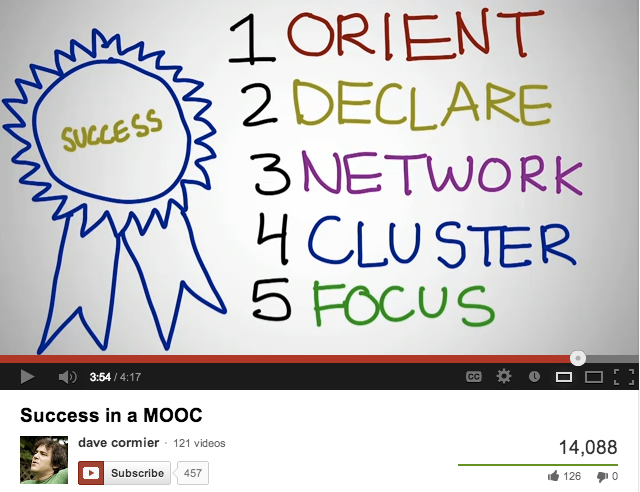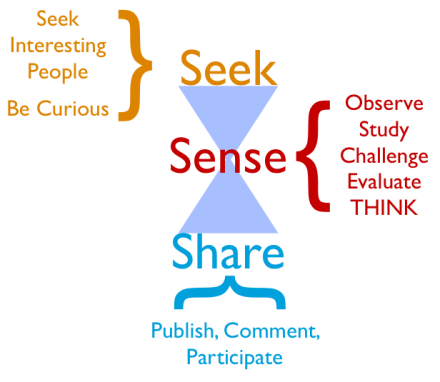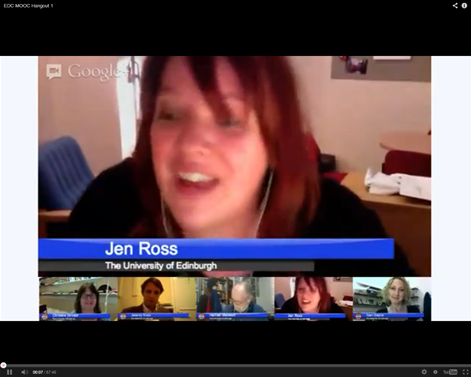
David Cormier has created a nice little video animation that quickly and clearly describes 5 simple steps to learning in a MOOC. They are:
- Orient — find out where everything is, what are the key deadlines, etc
- Declare — put your ideas out there in some place — discussion list, blog, tweet, FB post, etc
- Network — find people who you find to be of interest, reply, retweet, and comment on what they have said
- Cluster — pull together or join a group of folks who you will share the learning experience with.
- Focus — remain clear on what you want to get out of the experience and try to remain true to that without getting distracted.
While Cormier doesn’t say it, it seems that these steps do not necessarily have to happen in a linear order and that they could be shuffled around. I would put them in a networked pattern, much like the one Cormier draws for the network concept.
For instance, it might help to start with focus and learning goals and actually come back to them regularly to reassess or revisit them. Likewise, you might network and seek out individuals and ideas before declaring your own. You might do this with more than one concept and group. Also the idea of cluster might equally apply to concepts and themes as they do to people and groups.
A couple of other folks I’ve come across have also shared tips for success in a MOOC. Ilzele at Random Ramblings has her own 5 steps to MOOC success:
- Prioritze
- Skim
- Group-Up
- Organize
- Have Fun!!!.
Brittnay Chan at MOOC Nook shares her 4 steps for not being overwhelmed—
- Pick your favorite
- Start slowly – listening is great
- Don’t feel you have to do everything
- Have fun!!
So clearly there is overlap here. Echos of Cormier’s “focus” are in Ilzele’s “priortize” and Chan’s “pick your favorite.” Orienting (Cormier) and starting slowly (Chan) seem compatible. And Chan’s “listening is great” seems the perfect compliment to Cormier’s “declare.” Skimming and networking share the features of exploring new content and new people. Ilzele’s “group up” and “organize” seem to capture two different features of Cormier’s “cluster” — group up = clustering people and organize = clustering content. Both Ilzele and Chan want us to “have fun” which also seems embodied in Chan’s “Don’t feel you have to do everything.”
So it would seem that there are both content and interaction lessons. And as I consider these bits of shared wisdom and insight, the metaphor that comes to mind is that of a journey rather than a classroom. This is not a new nor original metaphor for learning, but it might help to have this metaphor rather than the mental model of a classroom. If I am on a knowledge quest rather than fulfilling a requirement or an external expectation of achievement I might find more joy and excitement.
LIke any good journey, I would as Cormier suggests orient myself to the environment. I would perhaps prioritize, focus or map the key places I’d like to visit. I would make time to explore interesting people, resources and content. I would share my stories as well as listen to those of others. I would collect and organize treasures found in a knapsack and capture my insights and reflections. And at the end of the journey, I’d make time to take stock and assess where I had been and where I might go next.
So other things that come to mind with the metaphor of a journey — when and what role does a guide (in the person or information format) play in the journey? Do you always need one? How about a translator? How do you know what to pack or prepare ahead of time? How do you find help when you are in trouble? What are the other things required of a journey into learning?
Looks like Amy Burvall has some interesting things to say about exploring in asserting that we should become digital Vikings.
#edcmooc




